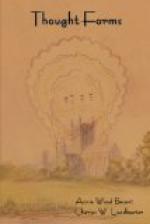[Illustration: PLATE G. MUSIC OF GOUNOD]
The colouring here is far more brilliant and massive than in Plate M, for this music is not so much a thread of murmurous melody as a splendid succession of crashing chords. The artist has sought to give the effect of the chords rather than that of the separate notes, the latter being scarcely possible on a scale so small as this. It is therefore more difficult here to follow the development of the form, for in this much longer piece the lines have crossed and intermingled, until we have little but the gorgeous general effect which the composer must have intended us to feel—and to see, if we were able to see. Nevertheless it is possible to discern something of the process which builds the form, and the easiest point at which to commence is the lowest on the left hand as one examines the Plate. The large violet protrusion there is evidently the opening chord of a phrase, and if we follow the outer line of the form upward and round the circumference we may obtain some idea of the character of that phrase. A close inspection will reveal two other lines further in which run roughly parallel to this outer one, and show similar successions of colour on a smaller scale, and these may well indicate a softer repetition of the same phrase.
Careful analysis of this nature will soon convince us that there is a very real order in this seeming chaos, and we shall come to see that if it were possible to make a reproduction of this glowing glory that should be accurate down to the smallest detail, it would also be possible patiently to disentangle it to the uttermost, and to assign every lovely touch of coruscating colour to the very note that called it into existence. It must not be forgotten that very far less detail is given in this illustration than in Plate M; for example, each of these points or projections has within it as integral parts, at least the four lines or bands of varying colour which were shown as separate in Plate M, but here they are blended into one shade, and only the general effect of the chord is given. In M we combined horizontally, and tried to show, the characteristics of a number of successive notes blended into one, but to keep distinct the effect of the four simultaneous parts by using a differently-coloured line for each. In G we attempt exactly the reverse, for we combine vertically, and blend, not the successive notes of one part, but the chords, each probably containing six or eight notes. The true appearance combines these two effects with an inexpressible wealth of detail.




